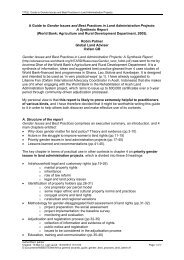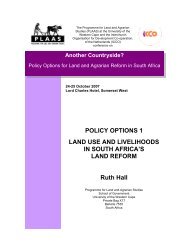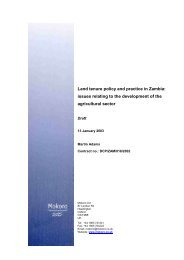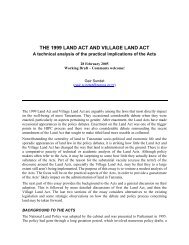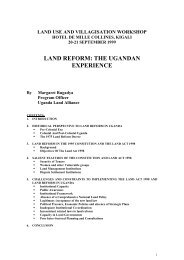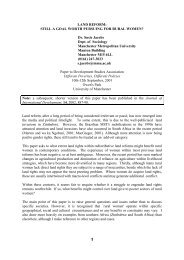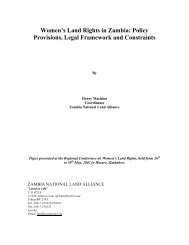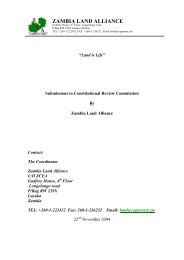Malawi National Land Policy - Mokoro
Malawi National Land Policy - Mokoro
Malawi National Land Policy - Mokoro
You also want an ePaper? Increase the reach of your titles
YUMPU automatically turns print PDFs into web optimized ePapers that Google loves.
Ministry of <strong>Land</strong>s Page 16<br />
Less national Parks, Forest and Game Reserves, 1.7 18<br />
<strong>Land</strong> Available for Agriculture 7.7 82<br />
<strong>Land</strong> Available for Smallholder Agriculture and Estates 7.7 100 82<br />
Estimated land Under Estates 1.2 16 13<br />
<strong>Land</strong> Available for Smallholders 6.5 84 69<br />
2.1.4. According to the <strong>National</strong> Statistic Office (NSO), 55% of smallholder farmers have less<br />
than 1 hectare of cultivable land, which does not meet their basic food needs. As a result, more<br />
than half of the population lives below the poverty line of US$140 per capita income annually.<br />
In absolute terms, the poverty of the country is predominantly rural and is reflected in the<br />
below average social indicators. The illiteracy rate is about 56% for the overall population.<br />
Malnutrition is widespread, and the child mortality rate at 238 per 1000 is among the highest in<br />
the world.<br />
2.1.5. Overall macroeconomic growth declined from 10.3% in 1998 to an average annual rate of<br />
4.1% in 2000 and 2001 with the decline in the tobacco market. The smallholder sector, which<br />
contributed over 43% of GDP, also accounts for 87% of the labor force, although its<br />
productivity has fluctuated since 1981. For example, production declined by 3.1% in 1997, but<br />
was followed first by strong average growth of about 12% in 1998 and 1999 and a sharp decline<br />
to 3.5% in 2000 and 2001. Over the same period, the contribution of the estate sector saw a<br />
steady increase as more and more land was converted to tobacco, tea, and sugar production.<br />
Furthermore, <strong>Malawi</strong>’s economy has been plagued with a variety of problems. Periods of<br />
severe drought have combined with high population growth and rising inflation to increase<br />
<strong>Malawi</strong>’s dependence on international aid. To make matters worse, efforts to adjust the<br />
structure of the economy by bringing administrative and fiscal discipline have also contributed<br />
to cuts in social services and a decline in government expenditure in real terms.<br />
2.1.6. This overall decline of real incomes has had the consequence of increasing poverty for<br />
the majority of citizens. The smallholder sub-sector has also exacerbated the problems of under<br />
investment by their reliance on primitive technology. These have resulted in serious<br />
environmental degradation, especially deforestation, soil and habitat losses. In this setting,<br />
understanding the evolution of land policy and the legal regime governing the country's land<br />
resources is an important first step in the development of future land management strategies.<br />
2.2 The Evolution of <strong>Land</strong> Law<br />
2.2.1. The essence of colonial land policy in <strong>Malawi</strong> was to appropriate all land to the British<br />
sovereign and to facilitate access by the settler community on the basis of private title. The<br />
policy also redefined native rights strictly as "occupation rights" in order to discourage the<br />
establishment of land rights equivalent to freehold or the concessions claimed by the settlers.<br />
2.2.2. The presence of European settlers led to the passage of the Nyasaland Order in Council,<br />
1902 and allowed the general application of English law supplemented by specific enactments<br />
based on English property law. This clause remained the sole source of the substantive law of<br />
http://www.malawi.gov.mw/lands/landpol.htm 29/03/2005 15:23:13




